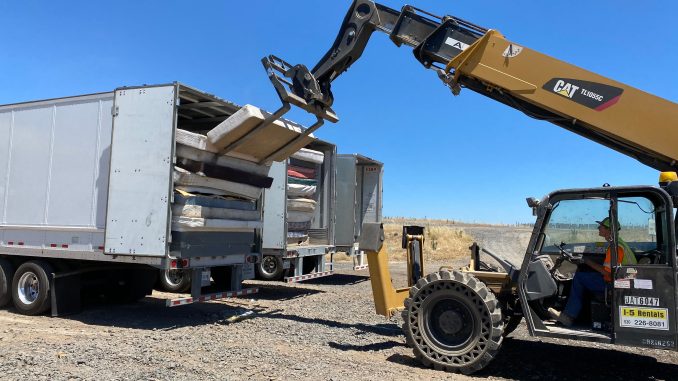
How do you squeeze in more stuff? That’s not only an issue for residents with overstuffed closets and packed garages; it’s a constant puzzle at Neal Road Recycling and Waste Facility.
Like a closet, Butte County’s primary landfill has only limited capacity. One solution: Reduce the stuff that needs to fit into that space.
In particular, the facility focuses on recycling–especially large, bulky items. That dramatically reduces waste volumes and provides materials for useful products.
The Neal Road facility, also known as NRRWF, operates a self-service recycling drop-off area that accepts mattresses and box springs, large appliances, water heaters, carpeting and electronic waste such as TVs and microwaves. It also accepts flattened cardboard, scrap metal, auto batteries and bicycles.
Mattress recycling has been a popular program for both residents and land operators. NRRWF has participated in the Mattress Recycling Council’s Bye-Bye Mattress program since 2016.
“NRRWF’s mattress recycling program is a huge success,” says Eric Miller, manager of the Waste Management Division for Butte County Public Works. “Consumers pay around $10.50 per mattress–$21 per mattress and box spring–at the point-of-purchase when buying a new mattress. This fee covers the cost of labor, transportation and recycling. The MRC Bye-Bye Mattress program is an excellent model for end-of-life product stewardship.”
Mattresses have always been a challenge at landfills.
“Landfill operators dislike burying mattresses,” Miller says. “The springs entangle equipment. Plus mattresses float through the waste, like tires that spring back, and can pop out of side slopes (in the landfill).”
Waste collectors don’t like them either.
“Mattresses are a menace to commercial garbage truck drivers,” Miller notes. “A king-size bed takes more than 54,000 cubic inches of space, about the same volume as four medium-sized trash cans.”
The Neal Road facility accepts about 18,000 mattresses a year, Miller says. Stacked atop each other, those mattresses nearly reach the height of Lassen Peak. Lined end to end, they stretch 23 miles–the distance between Oroville and Chico.
“The mattresses are sent to a recycling facility in Woodland,” he adds. “NRRWF exports six to nine semi-trailer loads of mattresses each week. The textiles are removed and sent to rag markets, coils are separated for scrap metal markets, and wood can be used as biomass fuel to produce energy.”
The landfill benefits, too, says Miller. “At NRRWF, we save a lot of airspace when we recycle mattresses.”
For residents, the mattress drop-off service is free, says Miller. “Still, we find (mattresses) illegally dumped on Butte County roads. Why? It’s disappointing that some people have this attitude. It’s an eyesore, bad for the environment and wastes county resources to clean-up the mess.”
Like mattress recycling public outreach, Butte County Public Works is now working on educating residents about recycling organic waste, says Craig Cissell, deputy director of Butte County’s Waste and Recyling Division. Recycling food waste into compost can extend landfill life and reduce greenhouse gas emissions.
“Recycling and trash collection keeps evolving,” Cissell notes. “Until the ’90s, you filled one trashcan and didn’t think about pulling anything out except aluminum cans.”
Communities gradually added green or brown bins to collect green waste, he adds. “That meant three bins: one for trash, one for recyclables, and one for green waste. It was another small change to sort trash. CalRecycle may soon require a new separate bin for food waste, another change–and we’re still educating people about what goes where. Sure, there’s some initial shock and anxiety, but over a short period of time, sorting food waste will become as second nature.”
Learn more at https://www.buttecounty.net/publicworks.

